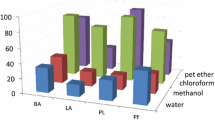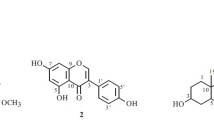Abstract
Two phenylpropanoid glucosides, namely acetylmartynoside A and 4″-O-acetylmartynoside, isolated from Aegiphila obducta (Verbenaceae) were studied for insect antifeedant activity against fourth-instar larvae of Chilo partellus (Lepidoptera: Pyralidae). Acetylmartynoside A showed weak antifeedant activity at all the concentrations tested while 4″-O-acetylmartynoside showed strong antifeedant activity, particularly at the higher concentrations of 400 and 500 μg/disk.
Résumé
Deux glucosides phenylpropanoidiques-acetylmartynoside A et 4″-O-acetyhnartynoside-isolés d’Aegiphila obducta (Verbenaceae) ont été étudiés pour leur activité phagodeterrente sur les larves du quatrième stade de Chilo partellus (Lepidoptera: Pyralidae). Acetylmartynoside A a montré un faible activité phagodéterrente à toutes les concentrations testées tandis que 4″-O-acetylmartynoside a montré une forte activité phagodeterrente, particulièrement aux plus hautes concéntrations de 400 et 500 μg/disque.
Similar content being viewed by others
References
Alghali A. M. (1985) Insect-host plant relationships. The spotted stalk-borer, Chilo partellus (Swinhoe) (Lepidoptera: Pyralidae) and its principal host, sorghum. Insect Sci. Applic. 6, 315–322.
Bell E. A. (1986) Plants as a source of novel pest control agents, pp. 661–667. In Proceedings of British Crop Protection Conference (BCPCP) Brighton, England (Edited by P. R. Days). BCPCP Publisher, Thornton Heath Surrey.
Cook A. G. (1976) A critical review on the methodology and interpretation of experiments designed to assay the phagostimulatory activity of chemicals to phytophagus insects, pp. 47–54. In The Host-Plant in Relation to Insect Behaviour and Reproduction (Edited by T. Jermy). Plenum Press, New York.
Cooper R., Solomon P. H., Kubo I., Nakanishi K., Shoolery J. N. and Occolowitz J. L. (1980) Myricoside, an African armyworm antifeedant: Separation by counter-current chromatography. J. Am. Chem. Soc. 102, 7955–7956.
Correa M. P. (1926) Dicionário das Plantas Úteis do Brasil e das Exóticas Cultivadas, Vol. II. Imprensa Nacional, Rio de Janeiro, Brasil, pp. 358–359.
Gross G. A., Lahloub M. F., Anklin C., Schulten H. R. and Sticher O. (1988) Teucrioside, a new glucoside from Tuecrium chamaedrys. Phytochemistry 27, 1459–1462.
Jacobson M. and Crosby D. G. (1971) Naturally Occurring Insecticides. Marcel Dekker Inc., New York. 585 pp.
Kimura Y., Okuda H., Nishibe S. and Arichi S. (1987) Effects of caffeoylglucosides on arachidonate metabolism in leukocytes. Planta Medica 53, 148–153.
Kumar S. and Singh D. (1995) Allelopathy in sustainable agriculture, forestry and environment—A review of an international symposium. Curr. Res. Med. Arom. Plants 17, 29–41.
Leitão S. G., Kaplan M. A. C. and Delle Monache F. (1994) Phenylpropanoid glucosides from Aegiphila obducta. J. Nat. Prod. 57, 1703–1707.
Molgaard P. (1986) Food plant preferences by slugs and snails: A simple method to evaluate the relative palatability of food plants. Biochem. Syst. Ecol. 14, 113–121.
Ochieng R. S., Onyango F. O. and Bungu M. D. O. (1985) Improvement of techniques for mass-culture of Chilo partellus (Swinhoe). Insect Sci. Applic. 6, 425–428.
Ravn H. and Brimer L. (1988) Structure and antibacterial activity of plantamajoside, a caffeic acid sugar ester from Plantago major subsp. major. Phytochemistry 27, 3433–3437.
Ravn H., Nishibe S., Sasahara M. and Xuebo L. (1990) Phenolic compounds from Plantago asiatica. Phytochemistry 29, 3627–3631.
Scarpati M. L. and Delle Monarche F. (1963) Isolamento dal Verbascum sinuatum di due nuovi glucosidi: Il verbasciside e l’isoverbascoside. Ann. Chim. 53, 356–367.
Shoyama Y., Matsumoto M. and Nishioda I. (1987) Phenolic glucosides from diseased roots of Rehmannia glutinosa var. purpurea. Phytochemistry 26, 983–986.
Author information
Authors and Affiliations
Additional information
See Editor’s Note at the end of this issue.
Rights and permissions
About this article
Cite this article
Leitão, S.G., Kaplan, M.A.C., Monache, F.D. et al. Antifeedant Activity of Two Phenylpropanoid Glucosides from Aegiphila obducta Against Chilo partellus Larvae. Int J Trop Insect Sci 16, 375–378 (1995). https://doi.org/10.1017/S1742758400017434
Accepted:
Published:
Issue Date:
DOI: https://doi.org/10.1017/S1742758400017434
Key Words
- Aegiphila obducta
- Verbenaceae
- Chilo partellus
- phenylpropanoid glucosides
- antifeedant
- acetylmartynoside A
- 4″-O-acetylmartynoside




